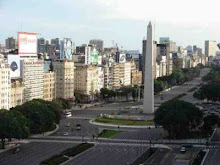If you are planning a trip to Argentina, Buenos Aires is a must!
Buenos Aires is the capital of Argentina and one of the most interesting and exciting cities in the world, where anything can happen and will happen.
With more than 13 million people living here between the capital district and the suburbs , the place is a mixture of cultures that have blended together creating a unique stereotype: The “Porteño” which means man of the Port. inspired in Buenos Aires origin as Port.
History
Buenos Aires is quite a new city in America, It was first founded in 1536 by Pedro de Mendoza but the indians “Querandies” faught against them and destroyed complete the settlement.
Finally in 1580 Juan de Garay founded for the second time the city of Buenos Aires where the Plaza de Mayo is located now. It was called Santisima Trinidad and the port was called Santa Maria de los Buenos Aires. At first, surviving the constantly attacks of the indians was the only possible activity.

Leonie Mathis - Santa maria del Buen Aire atacada por los Querandies 1536 -
A fort was built where the actual Casa Rosada is now. From there they could control the River Plate from any ship sailing towards the city. Today you can visit the old fort museum underneath the government house.
 Leonie Mathis - La Plaza mayor 1650 -
Leonie Mathis - La Plaza mayor 1650 - Even though Buenos Aires had an strategical location as a port it was clossed to commerce by the Government of Peru. For that reason smuggling was the second activity for surviving that desolated region.
Meanwhile all the cattle and horses brought by the conquerors from spain grew wild in the Pampas. The first settlers hunted this animals for some of its meat and skin, but soon realized it was an excellent product to trade with the English and Potuguese, which use the leather for army gear and the dry meat for food for the slaves.
In 1779 the Virreynato del Rio de la Plata was founded and Buenos Aires was no longer under the supervision of Peru. Commerce with Europe started to thrive and Buenos Aires turned to be the most important port in South America.

Leonie Mathis - La Plaza Mayor 1807 -
The city grew to be a wonderfull place, compared to cities like Paris. Architects from France and Italy designed most of the buildings following all the european trends. Unfortunately many of them were demolished, but still some places reminds of the early 20th century Paris streets.
 Leonie Mathis - Demolicion de la Recova 1884 -
Leonie Mathis - Demolicion de la Recova 1884 -

Leonie Mathis -Plaza de Mayo 1920-
Today Buenos Aires has grown to be a cosmopolitan city, center of every political, cultural and social event of the country.

La Casa Rosada Today
Geography The city of Buenos Aires covers around 200 square kilometers, but the city extends through its heavily inhabited suburbs for 70 km more. The area of Buenos Aires lies on a plain known as the "Pampas", which might be the biggest fertile plain in the world, where crops and cattle grow so well that in the begining of the 20th. century Argentina was called the "world barn".
The city of Buenos Aires covers around 200 square kilometers, but the city extends through its heavily inhabited suburbs for 70 km more. The area of Buenos Aires lies on a plain known as the "Pampas", which might be the biggest fertile plain in the world, where crops and cattle grow so well that in the begining of the 20th. century Argentina was called the "world barn".
The climate is very pleasent all year round, with a few days of extreme weather a year. You may find a slight rainy season in spring or fall. With all this climate changes going on there might be some storms with strong winds and even hail, specially when the wind from the southest blows, but nothing to care about. In fact those seasons are the best for visiting Buenos Aires because most of the days are temperate and the vegetation bursts with colors.
Neighborhoods
Buenos Aires has actually 48 official neighborhoods, although the famous tango refers to 100. Each neighborhood has its own history, culture and characteristics and in the city you will find areas within a neighbourhood with its own name different from the official one. That is how you have a Barrio Norte inside the Recoleta neighborhood which is the area surrounding the commercial Avenue Santa Fe. Las Cañitas is a small area between Palermo and Belgrano. Palermo is nowadays divided in to different areas known as Palermo Chico a very exclusive place, Palermo Soho, Palermo Hollywood, Alto Palermo and Palermo Queens, all part of Palermo neighbourhood or surrounding areas. Abasto is the area nearby the new Shopping center Abasto, where the central market used to be, Congreso and Tribunales are the areas near the National Congress and the Justice Palace.
As a tourist you will only visit just a few neighborhoods. Probably San Telmo, Puerto Madero, Downtown, Recoleta and Palermo.
If you have enough time I recomend visiting other neigborhoods outside the city for a day trip, like San Isidro, Tigre o La Plata.






Hi my wife and i spend a great time last month in Buenos Aires, we had rented a furnished apartment in Recoleta that was my favorite neighborhood in Buenos Aires cause it was near the down town. I suggest that service called ForRent Argentina: Buenos Aires apartments For Rent
ReplyDeleteCheers
Billy